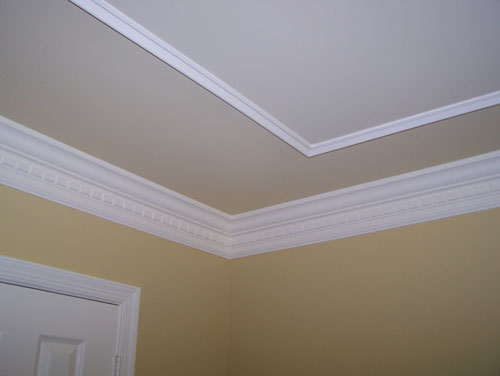Dunes Painting finished up a recent commercial project for a new Burlington Coat Factory in North Charleston, South Carolina.
Continue readingFleet Feet at the Grande Dunes Shopping Complex
We’re almost finished painting the walls for the new Fleet Feet in Myrtle Beach at the Grande Dunes Publix shopping complex.
Continue readingThe Library at Horry-Georgetown Technical College and The Retreat At Glenn’s Bay
Wallpaper removal, patching, priming and painting at HGTC. Also starting another project at the Retreat At Glenn’s Bay – wood repair, priming, and painting.
Continue readingInterior Painting Tips – Things to Consider
Now, when it comes to interior decoration of your home, one of the most important things that have to be taken into thorough consideration is the paint job. Failing to get it done properly is likely to cause dry spots and irregularities that you most certainly want to avoid. With this in mind, below you are going to find a few professional tips that the majority of interior painters in Myrtle Beach are using to deliver top-notch quality. Let’s take a look.
Continue readingPainting Ceilings
Ceilings are the most difficult areas to paint, but well worth the effort. With a few simple steps ceiling painting can be much easier and produce better results. Many of the same procedures when rolling ceilings are the same as the walls.
The general plan for painting ceilings is to prepare the room, repair any damage, cut in the edges with a brush and then apply the paint to the large areas. The best plan is to finish the entire ceiling painting in one session. Allowing the paint to dry at different times will produce visible lap marks.
Preparation
Before starting the ceiling painting remove as much furniture as possible, any remaining pieces need to be moved to the center of the room.
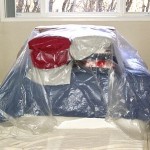 Cover the entire floor with good drop cloths and the furniture with lightweight plastic.
Cover the entire floor with good drop cloths and the furniture with lightweight plastic.Plastic on the floor will not work. It won’t stay put and will stick to your feet.
Place masking paper over the tops of the window and doorframe. Also cover any windowsills. These areas can be completely covered with plastic masking film for extra protection. Use a hand held masking machine for the paper and plastic.
Any remaining items will need to be covered with light weight plastic. Hanging pictures and unmoved furniture are good examples. Completely covering the walls is not necessary if a quality roller cover and quality paint is used.
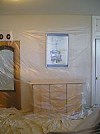
This will speed up the time to cut around the fixture with a brush. Drape plastic or masking paper over the light fixture to protect it from any splatters.
A ceiling fan can be masked with either masking paper on the blades or draped with plastic and taped secure. Most fans have a removable cover over the motor. Remove this cover if possible.
Repair drywall cracks and any damage before proceeding with the ceiling painting. Stains from water damage need to be sealed with a stain blocking primer. Apply 2 coats to be sure the stain is fully sealed. Use an appropriate interior primer for your particular situation.
Tools for Painting Ceilings
The best tools are the same as for painting walls. Use a 9-inch paint roller frame and a lambs wool roller cover.
The thickness of the cover depends on the amount or lack of texture on the ceiling, 1/2 inch for smooth and 3/4 inch for textured ceilings.
A roller pole is necessary and will save you a lot of time and effort. Choose a roller pole that is comfortable to use and extends far enough to reach over any obstacles.
To complete a professional roller set-up use a 5-gallon bucket and roller screen instead of a pan. A good paintbrush is needed to cut-in the edges and around any light fixtures. A 2-1/2—3 inch brush will work well. Use a size and style you are comfortable using.
Good tools are as important as quality paint.
Ceiling Paint
The type of paint and sheen will affect the overall appearance of the ceiling.
- For most ceiling painting jobs I recommend a high quality flat paint. Flat paint will dry evenly and is less likely to show roller lap marks. Plus flat paints can hide some imperfections.
- Areas with high humidity will need a paint with at least a little sheen. Satin sheen acrylic paint is a good choice for most bathrooms. Semi-gloss can be used if more water resistance is needed, such as ceilings in shower stalls.
Typically top quality acrylic paints are thick and will need to be conditioned before use. Add a paint conditioner, such as Flotrol, instead of water. Water will make acrylic or latex paints splatter and drip more. For oil base paints use Penitrol instead of mineral spirits. Most oil base products won’t need any conditioning for rolling.
General Ceiling Painting Methods
For most ceilings I like to use a brush and roller. Of course a ceiling can be sprayed using an airless sprayer. I recommend this method for painting acoustic ceilings. Choosing to spray a ceiling will require a lot more masking and covering.
Painting ceilings with a brush and roller is a very “user friendly” method, needing the least experience and investment in tools. The steps needed are brushing next to the walls then rolling the paint using an efficient pattern. Brushing should occur first, if one coat of paint will be applied. For two coat applications quickly roll the ceiling then cut-in twice while waiting for the ceiling to dry.
Brushing
Start by cutting in the edge of the ceiling at the walls with your brush. Bring a strip of paint out on the ceiling 3-4 inches wide. If the light fixture is accessible cut it in as well. If not, brush around it at the end of the ceiling painting.
Careful and slow brushwork is needed in order to have a straight line. Take your time.
Tape doesn’t work very well, but can act as a guide making this task a little easier. Try to apply the smallest amount of paint possibe next to the tape, dry brushing, to reduce the amount of seepage under the tape.
Flat Ceiling Painting
Roll in a straight-line pattern. The use of a “W” or “V” pattern will spread the paint too thin and is more work than necessary. A straight pattern applied opposite of your main viewing angle will help hide any roller marks. By applying the paint in sections and working back and forth towards the door a wet edge can be maintained.
 |
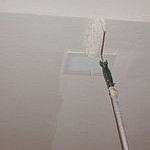 |
Begin rolling the ceiling parallel from the wall opposite of the entry door. An average stroke of the loaded roller will be 4-6 feet. This is about a third of the width of most rooms. Paint a section, 4×4 or 6×6 area, and then move over and repeat.
Blend each section while rolling by continuing each stroke into the previous section, overlapping 6 inches will be enough. Keep repeating this back and forth pattern until finished.
Rolling this way works great for smooth ceilings and paints that have a sheen, such as satin and semi-gloss. Ceilings without any texture are the most difficult to paint. Textured ceilings, orange peel and knockdown, are much easier.
Don’t press to hard on the roller. This will produce unnecessary splatters and drips. Plus, leave lines of thick paint coming off the ends of the roller cover.
Experiment on the first couple of strokes. Be careful when rolling close to the walls. To help this situation roll a band of paint next to the wall, do this as you roll a section. This will extend the brushed areas another 9 inches.
Vaulted Ceiling Painting
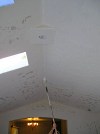
Begin applying the paint near a corner. Spread the paint in a straight-line pattern, overlapping each stroke into the previous one. Paint 1/2 of the ceiling at a time. Reduce the chance of hitting a wall by rolling slowly as you near the wall.
Source – http://www.house-painting-info.com/articles/ceiling-painting/
Interior Painting Tips
 Purchasing:
Purchasing:
– Buy a quart first instead of a large quantity in case you’re not committed to the color. Paint a piece of foam board and move it around the room to see how the light affects the color at different times of the day.
– Know the square footage of the room you are painting before you head to the store. The pros recommend one gallon for every 400 square feet. Covering textured, rough or unprimed surfaces may require more.
– Don’t apply latex on an oil finish and vice versa without first sanding the walls (remember to wear a mask) and wiping away the dust particles with a tack cloth. Apply a primer of the same composition (oil or latex) of the intended topcoat. To tell whether your current wall color is water- or oil-based, douse a white cloth with rubbing alcohol and rub it on the wall (in an out-of-the-way spot). If the paint softens and begins to transfer onto the cloth, it is water based. If the alcohol does not remove any color, it is oil-based.
– Don’t underestimate how long it’ll take you to get the job done. Allow at least 24 hours to dry before bringing everything back into the room. Allow two weeks to 30 days to cure before washing or wiping.
– Paints have volatile organic chemicals (VOCs ) that can release toxic gas into the air for years after a room has been painted. Buy eco-friendly paint with low-VOCs or zero-VOCs.-Paints with a green seal have a VOC of less than 50 grams/liter for flat and less than 150 grams/liter of non-flat.
Prep:
– Paint doesn’t stick very well to dirty walls, so clean them with soap and water (or TSP) and rinse with water once done. Let dry overnight.
– Clean ceilings before painting. There will be cobwebs and dust that you just don’t see. Use an old paintbrush or china bristle brush to dust baseboards, trim and crown molding before taping them off (use painter’s tape with paper attached to protect the baseboards). Overlap the tape seams by at least an inch to avoid seepage between pieces, and then seal the tape to the surface with your fingers or a rag.
– Don’t cover the floors with plastic as it can be very slippery. Use drop cloths or old sheets to protect them from splatters and drips.
– The color mixer at the paint store can create slight variations from can to can. The last thing you want is to have two shades of a color on the same wall. This can be remedied by mixing all of the paint cans together before you start painting to ensure you will have consistent color throughout the room.
– Fill holes with spackle using a five-in-one tool or wide blade and caulk where necessary. Sand dry spackle smooth, and prime each spot.
– Don’t underestimate how long it’ll take you to get the job done. Allow at least 24 hours to dry before bringing everything back into the room. Allow two weeks to 30 days to cure before washing or wiping.
– Removing outlet covers makes for a much neater paint job. Tape the screws to the cover, and tape over the outlet or light switch to keep paint from getting on them.
Painting Ceilings:
– Scaffolding comes in parts called “bucks” and “cross bucks”. For a high ceiling, four bucks should suffice. Each buck costs about $12 a day to rent. You’ll also need: walk boards or planks to place along the bucks, these rent for about $10 each per day. -Wheels rent separately for scaffolding. They are important because they allow you to move the scaffolding with ease. Four wheels rent for about $25 a day.
– When painting a textured ceiling, be sure to use a thick-nap roller to ensure that you get full coverage over the bumps and irregularities in the textured surface. For a smooth drywall ceiling, you can use a roller with a smooth or shorter nap.
Time-Saving Options:
– Use an edger instead of painter’s tape. Buy a good quality edger (they’re fairly inexpensive) and take your time in the corners so that you don’t spend all the extra time taping off everything.
– A 2-inch angled-sash brush can also be used for cutting into corners.-Hold it like a pencil and paint a steady line.
– If you take a break while painting, cover rollers in plastic wrap and refrigerate so that you don’t have to clean them every time you stop.
– Consider skipping the paint trays and using a five-gallon bucket with a roller screen inside. This saves time on filling and re-filling the bucket.
– Use a hammer and nail to poke holes in the rim of the paint can. It allows the paint to drip back inside the can after you pour it out.
Tools:
– Use a nylon-bristle brush for water-based paint and natural bristles for oil-based paint. Do not use natural bristles with water–based paint, the water can make the bristles limp. Foam brushes are good for intricate work such as painting molding or window casings. These brushes usually last for only one use because they’re hard to clean and easy to tear.
– If your project requires oil-based paint, natural bristles like ox or hog hair are perfect because they hold paint better than synthetic bristles.
– If you’re using latex paint, then nylon and polyester brushes are much better because they don’t absorb water like natural fibers.
– Good all-purpose brushes are flagged, meaning the bristles vary in length gradually coming to a peak in the middle of the brush. Flagged brushes provide a smooth, even, more precise layer of paint.
– Use the right roller for the job. For smooth surfaces like wallboard and wood, use a roller with a 3/8-inch or less nap. For surfaces with heavy texture, larger naps can reduce the number of coats — and the amount of time spent painting.
Clean Up:
– Use soap and water to clean latex paint off the brush immediately after painting. If the paint dries on the brush, you’ll need special solvents to remove it. If your house is on a public sewer system, you can clean the brushes in your sink, but be careful not to dispose of paint in an area where it might seep into the groundwater.
– For oil-based paints, you’ll need a solvent such as paint thinner or mineral spirits. Pour about two inches of thinner into a metal container and swirl the dirty brush in it until the paint comes off.
– Moist paintbrushes can be wrapped in plastic or waxed paper and sealed with a rubber band or aluminum foil. Hang brushes upside down to maintain their shape.
– Keep a stash of paint for touch-ups in a small plastic cup or glass jar, like margarine containers or baby food jars (thoroughly cleaned, of course). Be sure to label each container with the color and brand name.
– A common problem known as “hatbanding” occurs when painters use a paintbrush for cutting in and a roller to apply the rest of the paint, thus producing a different texture along the ceiling and trim. To prevent hatbanding, roll the paint as close to the cut-in areas as possible.



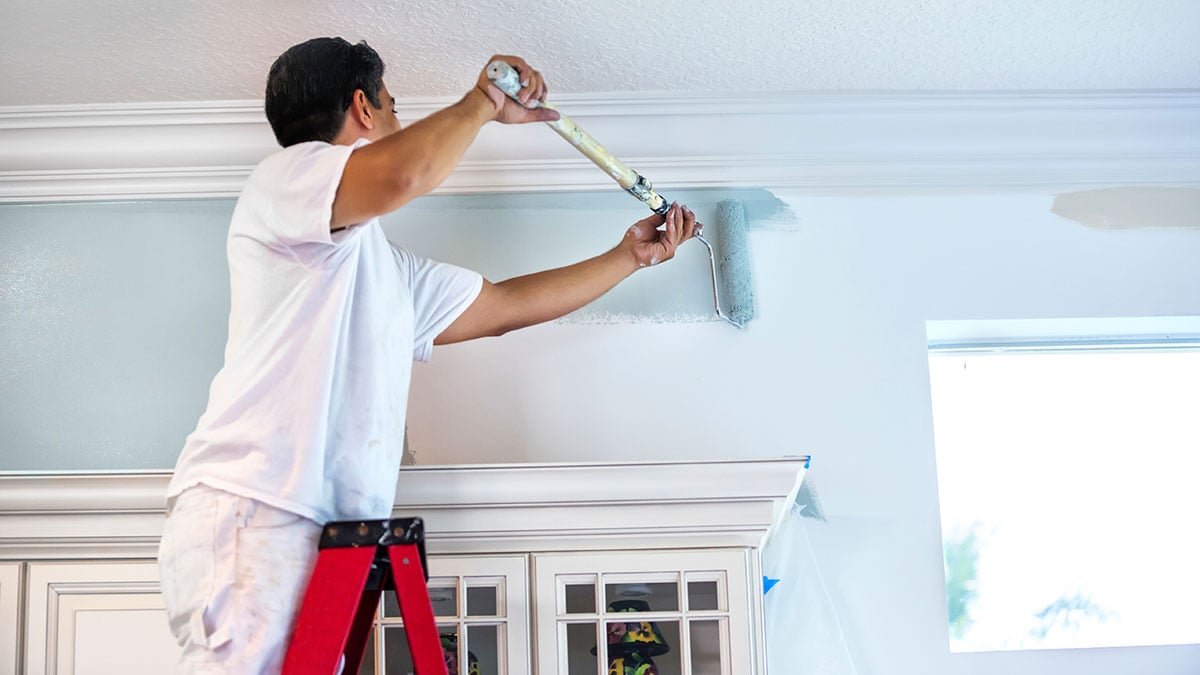
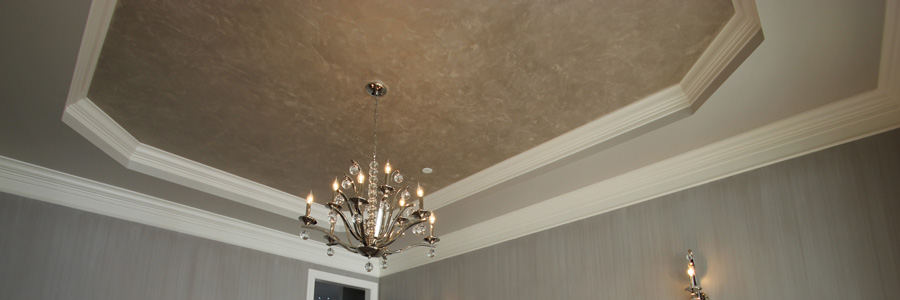

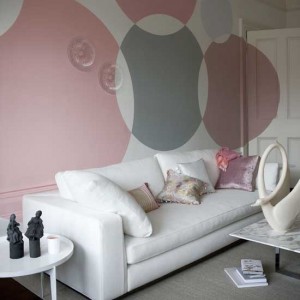 Purchasing:
Purchasing: